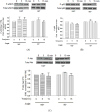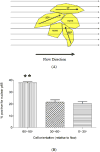Endothelial cell sensing of flow direction
- PMID: 23814115
- PMCID: PMC3812824
- DOI: 10.1161/ATVBAHA.113.301826
Endothelial cell sensing of flow direction
Abstract
Objective: Atherosclerosis-prone regions of arteries are characterized by complex flow patterns where the magnitude of shear stress is low and direction rapidly changes, termed disturbed flow. How endothelial cells sense flow direction and how it impacts inflammatory effects of disturbed flow are unknown. We therefore aimed to understand how endothelial cells respond to changes in flow direction.
Approach and results: Using a recently developed flow system capable of changing flow direction to any angle, we show that responses of aligned endothelial cells are determined by flow direction relative to their morphological and cytoskeletal axis. Activation of the atheroprotective endothelial nitric oxide synthase pathway is maximal at 180° and undetectable at 90°, whereas activation of proinflammatory nuclear factor-κB is maximal at 90° and undetectable at 180°. Similar effects were observed in randomly oriented cells in naive monolayers subjected to onset of shear. Cells aligned on micropatterned substrates subjected to oscillatory flow were also examined. In this system, parallel flow preferentially activated endothelial nitric oxide synthase and production of nitric oxide, whereas perpendicular flow preferentially activated reactive oxygen production and nuclear factor-κB.
Conclusions: These data show that the angle between flow and the cell axis defined by their shape and cytoskeleton determines endothelial cell responses. The data also strongly suggest that the inability of cells to align in low and oscillatory flow is a key determinant of the resultant inflammatory activation.
Keywords: atherosclerosis; hemodynamics; mechanotransduction, cellular.
Figures








References
-
- Berk B. Atheroprotective Signaling Mechanisms Activated by Steady Laminar Flow in Endothelial Cells. Circulation. 2008;117:1082–1089. - PubMed
-
- Chatzizisis Y, Coskun A, Jonas M, Edelman E, Feldman C, Stone P. Role of endothelial shear stress in the natural history of coronary atherosclerosis and vascular remodelingmolecular, cellular, and vascular behavior. Journal of the American College of Cardiology. 2007;49:2379–2393. - PubMed
-
- Malek A, Alper S, Izumo S. Hemodynamic shear stress and its role in atherosclerosis. JAMA: The Journal of the American Medical Association. 1999;282:2035–2042. - PubMed
Publication types
MeSH terms
Substances
Grants and funding
LinkOut - more resources
Full Text Sources
Other Literature Sources
Medical

